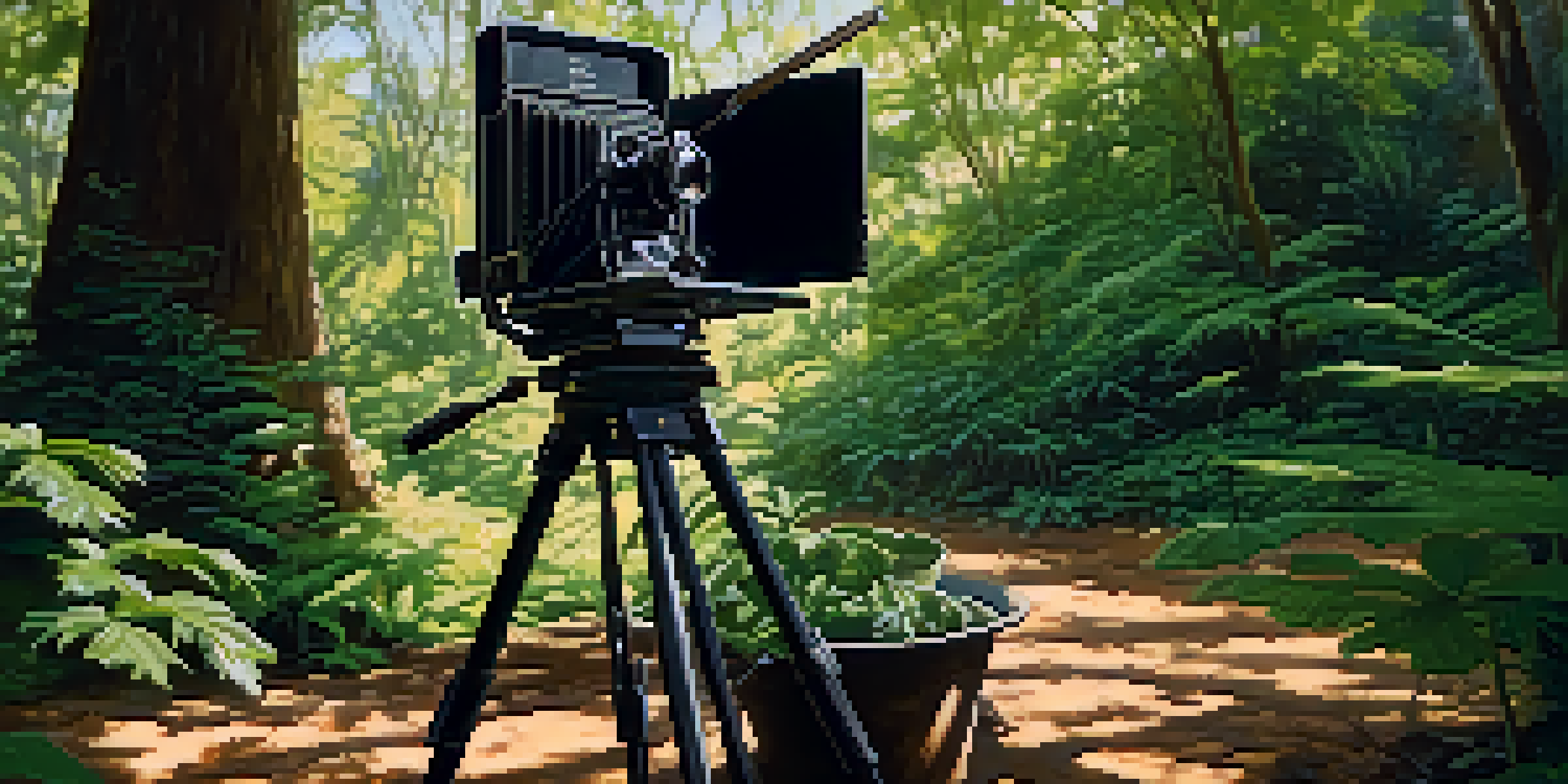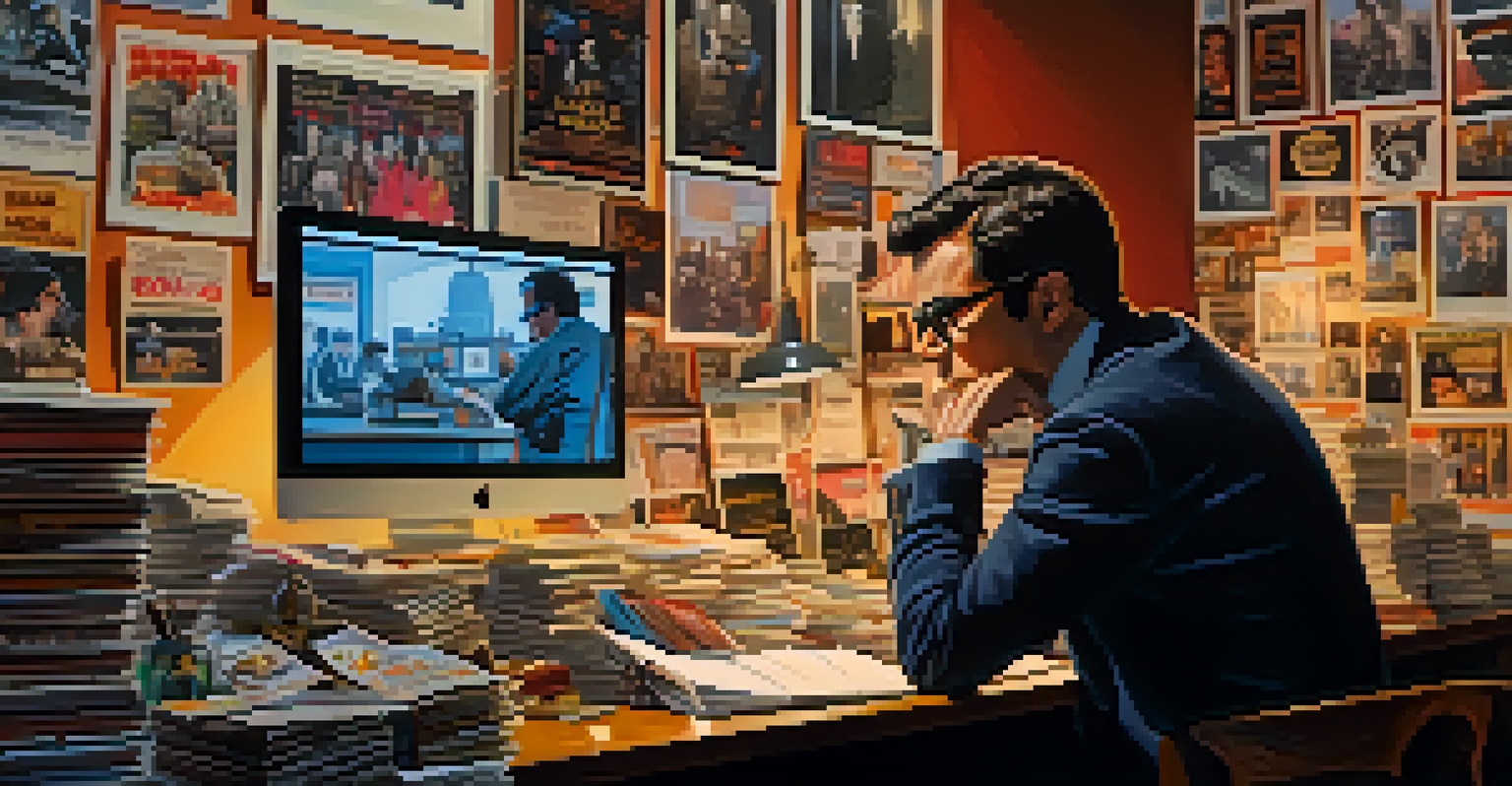Film Critique: Bridging Art and Society Through Discussion

Understanding Film Critique and Its Purpose
Film critique is more than just reviewing a movie; it's a deep dive into the themes, techniques, and cultural implications of a film. It invites viewers to think critically about what they watch and encourages a dialogue that can bridge personal experiences with broader societal issues. By analyzing elements like direction, cinematography, and storytelling, critics can illuminate the layers of meaning behind a film's surface.
Film is a social process, a process of sharing, a process of understanding, a process of communication.
Critics often serve as guides, helping audiences navigate the complex landscape of cinema. They draw connections between the film's content and the societal contexts in which it exists, making it easier for viewers to understand the relevance of a film. This can lead to enriching discussions that extend beyond the screen and into our own lives.
Ultimately, film critique is about fostering a deeper appreciation for cinema as an art form. It challenges us to consider not just what we see, but why it matters, prompting us to engage with the world around us through the lens of film.
The Role of Film in Reflecting Society
Films often hold a mirror to society, reflecting its values, struggles, and transformations. Whether it’s a poignant drama that tackles social justice or a light-hearted comedy that pokes fun at cultural norms, cinema has the power to capture the zeitgeist. This reflection can provoke thought and inspire change, making film a vital tool for social commentary.

For example, films like '12 Years a Slave' and 'Parasite' not only tell compelling stories but also invite viewers to confront uncomfortable truths about race and class. By engaging with such narratives, audiences can better understand the complexities of society and their own roles within it. This connection is essential for fostering empathy and dialogue.
Film Critique Enhances Understanding
Film critique invites deeper engagement with cinema, prompting audiences to explore themes and their societal relevance.
Moreover, the ways in which films represent different communities can spark conversations about representation and inclusivity. When critics highlight these aspects, they help audiences recognize the importance of diverse storytelling and its impact on cultural understanding.
Engaging Audiences Through Film Discussion
Film critique opens up a space for audiences to share their perspectives and interpretations. Discussions can take place in various settings, from film festivals to online forums, where viewers can express their thoughts and feelings. This exchange of ideas enriches the viewing experience and fosters a sense of community among film lovers.
Cinema is a matter of what's in the frame and what's out.
For instance, after watching a thought-provoking film, a group discussion can lead to deeper insights. Participants may share personal anecdotes that resonate with the film's themes, creating a richer understanding for everyone involved. This communal aspect of film appreciation enhances our connection to both the art and each other.
In this way, film critique becomes a collaborative journey, where each viewer's voice contributes to a larger narrative. It emphasizes that cinema is not just a solitary experience but a shared cultural phenomenon that invites us all to participate.
The Impact of Social Media on Film Critique
In today's digital age, social media plays a pivotal role in how film critique is disseminated and discussed. Platforms like Twitter, Instagram, and TikTok allow film enthusiasts to share their thoughts instantly, creating a vibrant dialogue around new releases. This accessibility democratizes film critique, enabling voices that might not have been heard in traditional media.
For example, a short video review on TikTok can quickly go viral, sparking conversations that reach a broad audience. This phenomenon highlights the power of grassroots criticism, where anyone with a passion for film can contribute their insights. It fosters a sense of ownership among viewers, who may feel more empowered to engage with cinema critically.
Cinema Reflects and Influences Society
Films serve as mirrors to society, capturing its values and struggles while sparking conversations about important social issues.
However, with this influx of opinions, it becomes essential to discern quality critique from mere opinion. Encouraging thoughtful discussions on social media can elevate the conversation and ensure that film critique remains a valuable tool for examining art and society.
Film Critique and Its Educational Value
Film critique is not just for cinephiles; it holds significant educational value. In academic settings, analyzing films can foster critical thinking skills, encouraging students to dissect narratives and understand their contexts. This practice helps develop a more nuanced understanding of the world, making it a valuable tool for educators.
By integrating film studies into curricula, educators can engage students with historical events, social issues, and cultural movements. For instance, a class discussion around 'Schindler's List' can lead to explorations of the Holocaust, morality, and human rights. This multi-faceted approach deepens students' understanding and invites them to draw connections between film and real-life implications.
Furthermore, the analytical skills gained through film critique extend beyond the classroom. Students learn to approach various media with a critical eye, equipping them to navigate an increasingly complex media landscape.
Challenging Norms and Sparking Change Through Film
One of the most powerful aspects of film critique is its ability to challenge societal norms and provoke change. Films that push boundaries often become the focal point of critical discussions, highlighting issues such as inequality, discrimination, and environmental concerns. Critics play a crucial role in bringing these topics to the forefront, encouraging audiences to reconsider their perspectives.
Consider films like 'The Handmaid's Tale' or 'Boys Don't Cry', which confront gender roles and identity. By critiquing these films, audiences can engage in discussions that challenge their own beliefs and biases. This process is essential for societal growth, as it opens up avenues for empathy and understanding.
Social Media Shapes Film Discussions
The rise of social media democratizes film critique, allowing diverse voices to share insights and engage in meaningful dialogues.
Moreover, when films inspire movements or shifts in public opinion, it's often due to the conversations sparked by critiques. This illustrates the potent relationship between cinema, critique, and societal change, underscoring the importance of open dialogue.
The Future of Film Critique: Innovation and Inclusivity
As we look to the future, the landscape of film critique is evolving. With advancements in technology and changing cultural dynamics, there's a growing emphasis on innovation and inclusivity. This shift encourages a broader range of voices, perspectives, and storytelling techniques, enriching the film critique landscape.
Emerging platforms, such as podcasting and vlogging, allow critics to present their analyses in diverse formats. This not only caters to different audiences but also helps democratize the critique process, making it more accessible. As a result, more individuals can engage with cinema on their own terms.

Moreover, the push for inclusivity ensures that underrepresented voices are amplified in the critique space. By valuing diverse perspectives, we can create a richer dialogue that reflects the complexity of our society. This evolution promises a vibrant future for film critique, where art and societal discussion continue to intersect.